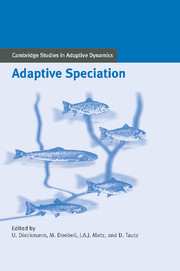Book contents
- Frontmatter
- Contents
- Contributing Authors
- Acknowledgments
- Notational Standards
- 1 Introduction
- 2 Speciation in Historical Perspective
- A Theories of Speciation
- 3 Genetic Theories of Sympatric Speciation
- 4 Adaptive Dynamics of Speciation: Ecological Underpinnings
- 5 Adaptive Dynamics of Speciation: Sexual Populations
- 6 Genetic Theories of Allopatric and Parapatric Speciation
- 7 Adaptive Dynamics of Speciation: Spatial Structure
- B Ecological Mechanisms of Speciation
- C Patterns of Speciation
- References
- Index
5 - Adaptive Dynamics of Speciation: Sexual Populations
Published online by Cambridge University Press: 05 July 2014
- Frontmatter
- Contents
- Contributing Authors
- Acknowledgments
- Notational Standards
- 1 Introduction
- 2 Speciation in Historical Perspective
- A Theories of Speciation
- 3 Genetic Theories of Sympatric Speciation
- 4 Adaptive Dynamics of Speciation: Ecological Underpinnings
- 5 Adaptive Dynamics of Speciation: Sexual Populations
- 6 Genetic Theories of Allopatric and Parapatric Speciation
- 7 Adaptive Dynamics of Speciation: Spatial Structure
- B Ecological Mechanisms of Speciation
- C Patterns of Speciation
- References
- Index
Summary
Introduction
When John Maynard Smith (1966) wrote on sympatric speciation more than 35 years ago, he acknowledged that the argument “whether speciation can occur in a sexually reproducing species without effective geographical isolation” was an old problem and voiced his opinion that the “present distribution of species is equally consistent either with the sympatric or the allopatric theory.” Yet, from the heyday of the Modern Synthesis until relatively recently, the importance of sympatric speciation has been downplayed, and the corresponding hypotheses remained obscure well beyond Maynard Smith's seminal study.
Looking back from today's perspective, it is astounding that, for such a long period, the research community at large essentially turned a blind eye to sympatric speciation. Given the widely acknowledged difficulties involved in inferring past process from present pattern, one can only feel uneasy about a logic that claims to find evidence for the prevalence of allopatric speciation in the present-day distribution of species. To a large extent it seems to have been the scientific community's perception of the theory of sympatric speciation that has brought about a profound skepticism toward the broader empirical relevance of this speciation mode. Scientific attempts to overcome this skepticism have come and gone in waves. In the 1960s, luminaries of North American evolutionary biology pulled no punches when assessing the merit of such attempts.
- Type
- Chapter
- Information
- Adaptive Speciation , pp. 76 - 111Publisher: Cambridge University PressPrint publication year: 2004
- 12
- Cited by

